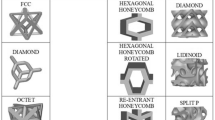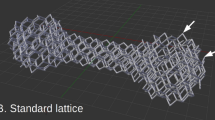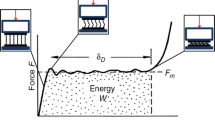Abstract
Additive manufacturing has opened new avenues for the manufacturing of structures to achieve challenging engineering tasks. Gyroid, a unique example of such structures, exhibits many attractive properties, such as high stiffness-to-weight ratio and impact characteristics. This study aimed to evaluate the dynamic performance of gyroid structures made from HS188 using direct metal laser melting. The frequency response predictions of a finite element-based model of the gyroid sandwich structure were first validated against the modal testing in terms of its natural frequencies and mode shapes using the Dewesoft software. Subsequently, the effects of the plate and gyroid wall thickness on the dynamic characteristics of the structure were investigated by varying these across their expected limit ranges as part of a parametric study using the validated finite element model. The findings from the parametric study were validated against modal testing. Moreover, the performance of the aforementioned structure was compared with that of a solid structure with the same mass. The simulation results indicated that the dynamic characteristics of the gyroid structure can be improved considering the structure’s frequency response by using parametric models. It was concluded that simulation and optimization tools will play a crucial role in additive manufacturing techniques to attain optimal mechanical properties of complex structures.


















Similar content being viewed by others
References
Gibson LJ, Ashby MF (1999) Cellular solids: structure and properties. Cambridge University Press, Cambridge
Harrias J, Winter R, McShane GJ (2017) Impact response of additively manufactured metallic hybrid lattice materials. Int J Impact Eng 104:177–191
Ozdemir Z, Tyas A, Goodall R, Askes H (2017) Energy absorption in lattice structures in dynamics: Nonlinear FE simulations. Int J Impact Eng 102:1–15
Kao Y-T, Amin AR, Payne N, Wang J, Tai BL (2018) Low-velocity impact response of 3d-printed lattice structure with foam reinforcement. Compos Struct 192:93–100
Chen L, Zhang J, Du B, Zhou H, Liu H, Guo Y, Li W, Fang D (2018) Dynamic crushing behavior and energy absorption of graded lattice cylindrical structure under axial impact load. Thin-Walled Struct 127:333–343
Beharic A, Egui RR, Yang L (2018) Drop-weight impact characteristics of additively manufactured sandwich structures with different cellular designs. Mater Des 145:122–134
Ferro CG, Varetti S, De Pasquale G, Maggiore P (2018) Lattice structured impact absorber with embedded anti-icing system for aircraft wings fabricated with additive SLM process. Mater Today Commun 15:185–189
Wen T, Tian J, Lu T, Queheillalt D, Wadley H (2006) Forced convection in metallic honeycomb structures. Int J Heat Mass Transfer 49(19-20):3313–3324
Wadley H, Queheillalt DT (2007) Thermal applications of cellular lattice structures. In: Materials science forum. Trans Tech Publ, vol 539, pp 242–247
Herrmann AS, Zahlen PC, Zuardy I (2005) Sandwich structures technology in commercial aviation. In: Sandwich structures 7: advancing with sandwich structures and materials. Springer, pp 13–26
Rupani SV, Jani S, Acharya D (2017) Design, modelling and manufacturing aspects of honeycomb sandwich structures: a review. Int J Sci Eng Dev Res 2:526–532
Choy SY, Sun C-N, Leong KF, Wei J (2017) Compressive properties of functionally graded lattice structures manufactured by selective laser melting. Mater Des 131:112–120
Kooistra GW, Deshpande V, Wadley H (2004) Compressive behavior of age hardenable tetrahedral lattice truss structures made from aluminium. Acta Mater 52(14):4229–4237
Ushijima K, Cantwell W, Mines R, Tsopanos S, Smith M (2011) An investigation into the compressive properties of stainless steel micro-lattice structures. J Sandw Struct Mater 13(3):303–329
O’Masta M, Dong L, St-Pierre L, Wadley H, Deshpande V (2017) The fracture toughness of octet-truss lattices. J Mech Phys Solids 98:271–289
Tang Y, Kurtz A, Zhao YF (2015) Bidirectional evolutionary structural optimization (beso) based design method for lattice structure to be fabricated by additive manufacturing. Comput Aided Des 69:91–101
Wang Y, Zhang L, Daynes S, Zhang H, Feih S, Wang MY (2018) Design of graded lattice structure with optimized mesostructures for additive manufacturing. Mater Des 142:114–123
Terriault P, Brailovski V (2018) Modeling and simulation of large, conformal, porosity-graded and lightweight lattice structures made by additive manufacturing. Finite Elem Anal Des 138:1–11
Chougrani L, Pernot J-P, Véron P, Abed S (2017) Lattice structure lightweight triangulation for additive manufacturing. Comput Aided Des 90:95–104
Panesar A, Abdi M, Hickman D, Ashcroft I (2018) Strategies for functionally graded lattice structures derived using topology optimisation for additive manufacturing. Addit Manuf 19:81–94
Du Y, Li H, Luo Z, Tian Q (2017) Topological design optimization of lattice structures to maximize shear stiffness. Adv Eng Softw 112:211–221
Maskery I, Sturm L, Aremu A, Panesar A, Williams C, Tuck C, Wildman R, Ashcroft I, Hague RJ (2018) Insights into the mechanical properties of several triply periodic minimal surface lattice structures made by polymer additive manufacturing. Polymer 152:62–71
Schoen AH. Infinite periodic minimal surfaces without self-intersections, NASA Technical Reports
Yoo D-J (2011) Computer-aided porous scaffold design for tissue engineering using triply periodic minimal surfaces. Int J Precis Eng Manuf 12(1):61–71
Afshar M, Anaraki AP, Montazerian H, Kadkhodapour J (2016) Additive manufacturing and mechanical characterization of graded porosity scaffolds designed based on triply periodic minimal surface architectures. J Mech Behav Biomed Mater 62:481–494
Abueidda DW, Bakir M, Al-Rub RKA, Bergström JS, Sobh NA, Jasiuk I (2017) Mechanical properties of 3d printed polymeric cellular materials with triply periodic minimal surface architectures. Mater Des 122:255–267
Al-Ketan O, Rowshan R, Al-Rub RKA (2018) Topology-mechanical property relationship of 3d printed strut, skeletal, and sheet based periodic metallic cellular materials. Addit Manuf 19:167–183
Yánez A., Cuadrado A, Martel O, Afonso H, Monopoli D (2018) Gyroid porous titanium structures: a versatile solution to be used as scaffolds in bone defect reconstruction. Mater Des 140:21–29
Maskery I, Sturm L, Aremu A, Panesar A, Williams C, Tuck C, Wildman R, Ashcroft I, Hague RJ (2018) Insights into the mechanical properties of several triply periodic minimal surface lattice structures made by polymer additive manufacturing. Polymer 152:62–71
Maskery I, Aremu A, Parry L, Wildman R, Tuck C, Ashcroft I (2018) Effective design and simulation of surface-based lattice structures featuring volume fraction and cell type grading. Mater Des 155:220–232
Altintas G (2018) Vibration properties of TPMS based structures. Int J Sci Technol Res 4:27–42
Maskery I, Aboulkhair NT, Aremu A, Tuck C, Ashcroft I (2017) Compressive failure modes and energy absorption in additively manufactured double gyroid lattices. Add Manuf 16:24–29
Abueidda DW, Elhebeary M, Shiang C-SA, Pang S, Al-Rub RKA, Jasiuk IM (2019) Mechanical properties of 3d printed polymeric gyroid cellular structures: experimental and finite element study. Mater Des 165:107597
Elmadih W, Syam WP, Maskery I, Chronopoulos D, Leach R (2019) Mechanical vibration bandgaps in surface-based lattices. Addit Manuf 25(April 2018):421–429
Monkova K, Monka P, Zetkova I, Hanzl P, Mandulak D (2017) Three approaches to the gyroid structure modelling as a base of lightweight component produced by additive technology. In: DEStech transactions on computer science and engineering, pp 124–129
Kavas B (2019) Compressive strength and characterization of additively manufactured double gyroid lattice structures, Master’s thesis, Istanbul Technical University
H. International, Haynes 188 properties. https://www.haynesintl.com/, date retrieved 2019-04-20
Matweb, Haynes 188 alloy, 0% cold reduction, 3.2 mm thick sheet. https://www.matweb.com/search/DataSheet.aspx?MatGUID=8681846d59904d1086ce346298a79347, date retrieved 2019-04-20
Simsek U, Gayir CE, Kavas B, Sendur P (2019) Computational and experimental investigation of vibration characteristic of variable unit cell gyroid structures, Pavia, SIM-AM, 2019
Funding
This study was carried out under the TUBITAK Technology and Innovation Support Program (Grant number: 5158001).
Author information
Authors and Affiliations
Corresponding author
Additional information
Publisher’s note
Springer Nature remains neutral with regard to jurisdictional claims in published maps and institutional affiliations.
Rights and permissions
About this article
Cite this article
Simsek, U., Arslan, T., Kavas, B. et al. Parametric studies on vibration characteristics of triply periodic minimum surface sandwich lattice structures. Int J Adv Manuf Technol 115, 675–690 (2021). https://doi.org/10.1007/s00170-020-06136-6
Received:
Accepted:
Published:
Issue Date:
DOI: https://doi.org/10.1007/s00170-020-06136-6







